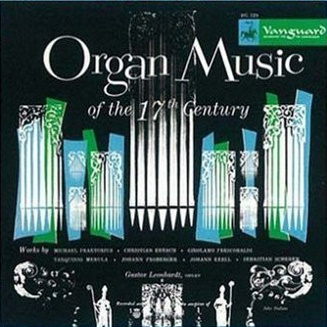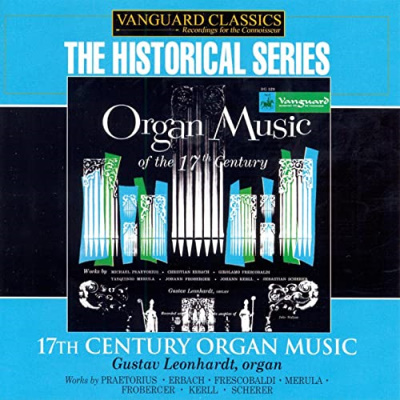 |
|
1 LP -
BG-529 - (p) 1954
|
 |
| 1 CD -
ATM-CD-1279 - (p) & (c) 2005 |
|
ORGAN MUSIC OF
THE 17TH CENTURY
|
|
|
|
|
|
|
|
| Michael PRAETORIUS (death 1621) |
Hymnus:
"A solis ortus cardine"
|
|
2' 41" |
A1 |
| Michael
PRAETORIUS |
Hymnus: "Alvus
tumescit virginis" |
|
1' 43" |
A2
|
| Christian
ERBACH (death 1635) |
Ricercar
IX Toni, sopra le fughe "Io son
ferito lasso" e "Vestiva i Coll."
|
|
5' 56" |
A3
|
| Girolamo FRESCOBALDI (death 1643) |
Toccata
prima - Toccate
d'intavolatura... Libro Primo (1637) |
|
4' 48" |
A4 |
| Tarquinio
MERULA (death 1653)
|
Sonata
chromatica |
|
5' 43" |
A5
|
| Johann
Jakob FROBERGER (death 1667)
|
Toccata |
|
5' 13"
|
B1
|
| Johann
Kaspar KERLL (death 1693)
|
Passacaglia |
|
7' 13" |
B2
|
| Johann
Kaspar KERLL
|
Toccata
cromatica con Durezze e
Ligature |
|
5' 04" |
B3 |
| Sebastian
Anton SCHERER (death 1712) |
Toccata
(1664) |
|
5' 12" |
B4 |
|
|
|
|
|
Gustav LEONHARDT,
Organ of the "Stiftskirche" at
Klosterneuburg, Austria, built in
1636-1642
|
|
|
|
|
|
Luogo
e data di registrazione |
|
Stiftskirche,
Klosterneuburg, Vienna (Austria) -
1954 |
|
|
Registrazione: live
/ studio |
|
studio |
|
|
Produced by |
|
Seymour Solomon
|
|
|
Engineer
|
|
-
|
|
|
Prima Edizione LP |
|
Vanguard - The Bach
Guild | BG-529 | 1 LP - durata 43'
33" | (p) 1954
|
|
|
Edizione CD |
|
Artemis Classics |
ATM-CD-1279 | 1 CD - durata 43'
33" | (p) & (c) 2005 | ADD
|
|
|
Cover Art
|
|
- |
|
|
Note |
|
Billboard, 4 december
1954
|
|
|
|
|
The
17th century is one of the
great periods in the vigorous
and adventurous expansion of
new musical resources. Opera,
oratorio, sonata, concerto,
violin music, keyboard music,
a veritable flood of vocal and
instrumental forms, and
experiments in dynamics,
harmony, instrumentation and
design, root themselves and
flourish steadily. Genesis is
inevitable, and so therefore
is the historian’s interest in
it. But it profits us little
to make the accurate and, in
some respects, relevant
observation that some of these
developments have their points
of origin in a prior century.
For all of the academicism of
certain phases of 17th century
musical theory and practice,
the dominant tone in both
fields is one of the opening up
of new tonal territories, and
of the conquest of new realms
of emotionality. The word
“new” occurs in the titles of
several significant
publications, and upon
occasion, the 17th century
composer is ready to sustain a
high polemical passion in
defense of this stylistic
novelty.
This concern with style,
structure and technique,
reflected in so many of the
pieces in this organ
anthology, and the rich
profusion of compositional
procedures which one finds not
only in organ music, but in
every main area of 17th
century music, can be
deceptive. Conditioned by the
historical peculiarities of
20th century musical
aesthetics, one tends to take
refuge in a complicated road
map guide to the complex of
interrelated developments of
style, structure and technique
regarded as formal absolutes.
However useful for the sake of
clarity, essentially this
misses the point. Few periods
illustrate better, or even as
well, an almost constant
concern for the expressive
potential of new techniques.
And since the functional roots
for music were still sturdy,
healthy and deep, most
composers were able, rather
readily, to test out in use
the validity of the new levels
of emotion, the new refinements
of feeling, which the
exploration of new resources
made available to them.
Perhaps most challenging in
terms of contemporary musical
practice, is the continually
healthy interplay of the
abstract, the expressive and
the functional in 17th century
music.
The singular vitality of organ
music in the 17th century is
in large measure rooted in the
livelihood it afforded the
composer. Organ playing was a
recognized profession and the
patronage extended to it came
from both church and court.
Every composer represented in
this anthology held a post as
an organist. Michael
Praetorius (1572-1621) - the
assumed name, a Latinization
of Schultze, meaning village
head man, hence praetor
- was organist first, and later
Kapellmeister and
secretary of the Duke of
Brunswick. Tarquino Merula,
whose published work appeared
between 1615 and 1652, was
organist at the court of
Sigismund III of Poland, and
later at S. Agata in Cremona,
Italy. Johann Jacob Froberger
(d. 1667), who studied with
Frescobaldi in Rome, became
court organist in Vienna upon
the accession of Ferdinand III
in 1637. The same Emperor sent
Johann Kaspar kerll
(1627-1693) to Carissimi in
Rome, although once there it
is not unlikely that he heard
Frescobaldi and learnt from
him. Kerll served as organist
both at the court of the
Bavarian elector in Munich,
and at the imperial court in
Vienna. Anton Sebastian
Scherer (1631-1712) was
cathedral organist in Ulm;
Christian Erbach (1573-1635)
held the equivalent post in
Augsburg; and Girolamo
Frescobaldi (1583-1643), the
greatest organist of his age,
held the coveted position of
organist at St. Peter’s in
Rome from 1608 until his
death, although for a period
(1638-1634) he left Rome to
become court organinst in
Florence.
Basically, as this
biographical review suggests,
the organ was perforce the
favorite instrument of these
composers and the medium most
natural to them for the
realization of creative
impulses, even when such
impulses were not directed
towards church service. This
was, of course, more true of
some than of others. More
true, for example, of
Frescobaldi than of
Praetorius; but as a
generalization it holds. One
finds in their organ music
(even in the less than great
examples) much of the
vitality, enthusiasm and
superlative workmanship, which
often characterize the work of
men who find themselves able
to operate as artists, and to
earn both a livelihood and a
respectable position in
society (Erbach, for example,
died a city councilor) through
this very operation.
Furthermore, travel was
creatively stimulating.
Despite the emergence of
strong regional organ styles,
the peregrinations of many of
these musicians were quite
typical for the period, and
the resultant exchange of
ideas contributed materially
to the advancement of the art.
However, if the functional
nature of the organ in church
and court chapel service, and
the security and social
standing conferred by court
and church patronage
conditioned the widespread
interest in the instrument,
this interest in turn led to a
far richer exploration of its
resources than was
necessitated simply by
liturgical function. In this
collection, only the
Praetorius pieces reflect a
clearly sacred orientation.
Both are polyphonic
elaborations over hymn
melodies, the polyphony
suggesting a rather
conservative leaning towards
16th century vocal polyphonic
practice. The first, A
solis ortus cardine
(Christ we praise in duty
bound) is a Latin hymn by
Coelus Sedulius. Luther did a
German translation of the text
(Christum wir sollen loben)
and Johann Walther adapted the
cantus melody. It is a
Christmas hymn. The second, Alvus
tumescit virginis (Lo! A
virgin has conceived) is a
setting of the third verse of
the Advent Hymn Veni
redemptor gentium (Come,
the Saviour is born). In both,
the cantus is in the pedals.
While the remaining pieces
reflect a much greater interest
in composition per se, or in
the art of the organist, than
in liturgical function, one
must remember the diversity
and elasticity of local
practice, and the possibility
that in a given instance a
free toccata might find place
for itself at some point of
the service.
The group of toccatas
presented here reflect
Frescobaldi's leadership in
this field. All follow his
manner of evolving the design
rather freely, avoiding both
the exuberantly
improvisational quality of the
Andrea Gabrieli toccatas with
their flinging together of
rapid scale passages and
massive chords, and the
schematic and seemingly
predetermined formal layout of
the Claudio Merulo toccatas.
The Frescobaldi and the
Scherer toccatas are rather
clearly display pieces, works
that could scarcely be
conceived in terms other than
the keyboard. The Frescobaldi,
in particular, with its
continual outcroppings of
running passages and
coloratura line, has much the
nature of a loosely fashioned
“touch-piece”, a work built up
by the free play of fingers on
a keyboard (which is what a
toccata-from toccare,
to touch-in its most
rudimentary sense is.)
Froberger achieves a more
evident degree of organization
through a more frugal use of
keyboard passage work, and
through a use (still
fragmentary) of a type of
coloratura keyboard figuration
that tends to suggest to the
ear a melodic line. Krell’s
toccata achieves its more
evident sense of continuity
through the exploitation, as
its title indicates, of the durezza
e ligature technique.
The phrase (which can also be
found in Frescobaldi, from
whom he may have taken the
idea) indicates a study in
tied notes and dissonances.
Both the Kerll toccata and the
Merula sonata indicate the
wholly characteristic interest
in chromaticism (there are
some stunning examples in
Frescobaldi); while
conversely, the Kerll
passacaglia derives much of
its essential strength from
its harmonic over
simplification, since in
essence it is founded upon a
recurring authentic cadence.
Erbach’s ricercar turns to
Italian secular vocal music
for its sources, and his
elaboration of the Io son
ferito may be compared
to Scheidt’s fantasia based
upon themes from this
Palestrina madrigal.
Notes
by Abraham Veinus,
Professor of Music,
Syracuse University
About the
Performance
Gustav M.
Leonhardt, born in 1928 in
Holland, has entered the
select circle of brilliant
instrumentalists who are also
ground-breaking scholars of
renaissance and Baroque music.
In his student years in
Holland, Switzerland and
Austria he won the highest
honors both for musicology and
performance on the harpsichord
and organ. He is one of the
acknowledged European masters
of the authentic ornaments and
improvisatory style of Baroque
music. In the spirit of the
old musician-artisans, he is
also an expert on the
construction and design of the
harpsichord and Baroque organ.
Since 1952 he has been
professor of harpsichord and
musicology at the Academy of
Music in Vienna, dividing his
time between Vienna and the
Conservatory at Amsterdam,
where he teaches as well.
This recording of 17th
Century Organ Music of
Southern Europe is one
of a series of recordings
being made by Mr. Leonhardt,
who is an exclusive
Vanguard-Bach Guild recording
artist. His recordings on
harpsichord of Bach’s Art
of Fugue and Goldberg
Variations have already
been established in American
musical life as classic
readings of these great works.
These performances of organ
works which are both beautiful
in their own right and throw
light upon the 17th century
development of musical form
will likewise stand as a
permanent testament to the
finest scholarship of our time
and models of performance in
the true Baroque tradition.
The organ on which Mr.
Leonardt plays on this
recording, that of the
“Stiftskirche” at
Klosterneuberg in Austria, is
one of the finest Baroque
organs in Europe. It was built
in 1636-42 by the organ
builder Georg Freundt of
Passan, who made use of part
of the pipework, and probably
also the organ case, of the
former 16th century organ. It
has 2179 pipes. Some
alterations were made in the
reeds during the 19th century,
but these were corrected,
after the 17th century design,
in recent years. The pitchof
the organ is one half tone
above our normal pitch. The
cover design is based on
photographs of the actual
organ.
|
  |
|
|